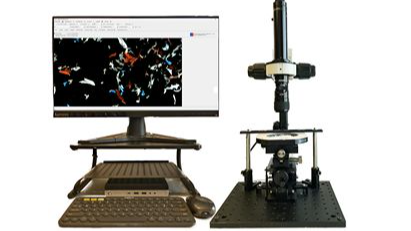
-- Introduction: It is now common knowledge that the world’s oceans and waterways have become littered with household and industrial plastic waste. While these macroplastics may be eye-sores, they do not directly affect human health.
However, it appears that plastic particles, invisible to the naked eye, may be the prime culprits impacting the human food chain and health. Consequently, monitoring and detecting microplastics less than 1mm in size is essential to gain insight into the relationship between microplastics and human health. See https://microplasticsdetection.com
According to a detailed report in the journal Nature*, "...over 300 million microplastic particles (mostly < 1 mm) could be released annually to the oceans through marine aquaculture alone. Fishmeal is both a source of microplastics to the environment and directly exposes organisms for human consumption to these particles.”
Existing Methods For Microplastic Detection Do Not Work Well: Detecting microplastics has been challenging due to methods that lack sensitivity, deliver false positives and negatives, and require skilled laboratory personnel.
One commonly used approach involves visually inspecting samples under a microscope, while another stains plastics to observe them later under laser fluorescence. Unfortunately, both options require complicated, time-consuming sample preparation, often with hazardous chemicals.
In addition, no dedicated software is available to measure the size of microplastic particles and determine their abundance.
ColSpec A User-friendly Alternative To Existing Methods: LightForm developed ColSpec® to simultaneously detect an unlimited number of microplastics smaller than 1 mm. ColSpec is a safe, technician-friendly instrument that only takes about one-tenth of a second to characterize a sample, often with little or no sample preparation.
The ColSpec Microplastic Detection Secret: “Critical Angle Darkfield Illumination (CADFI)”: The method used by ColSpec to detect microplastics relies on illuminating a sample with an intense LED light at a near-grazing critical angle.
CADFI causes plastic particles to appear as intensely bright objects against a dark or black background, enabling easy detection. On the other hand, biomaterials and sediments are weak light scatterers that either do not appear or may show up as dim background objects.
The brightness of the microplastics increases sensitivity and, with it, the opportunity to detect even the smallest microplastic particles. The system comprises a research-grade video camera, zoom magnifying optics, a CADFI darkfield reflection illumination system, and comprehensive software.
The software operates the camera and utilizes intelligent color-spectral imaging algorithms to identify microplastics and determine their size and abundance.
ColSpec detects all types of plastics, including polyethylenes, polycarbonates, acrylics, and styrenes, whether transparent, opaque, or colored. Note: ColSpec detects but does not identify the polymer in plastics. Zooming in on questionable particles reduces false positives or negatives.
ColSpec Software Uses Color-Spectra Imaging (CSI) for Microplastics Detection: CSI is a cousin of hyperspectral imaging spectroscopy (HSI) used in remote sensing. Whereas HSI uses reflection spectroscopy, ColSpec characterizes the field of view (FOV) in “color-space” (RGB, HSV, CMYK…)
Like remote sensing procedures, the operator trains color-spectral signatures to classify and recognize known plastic types. The software assigns CSI signatures that correlate with target plastics as “classes,” which form the constituents of a color-spectral library. Future samples will use these libraries to detect microplastic targets.
The software package controls the ColSpec camera and determines the size and abundance of “recognized” microplastics.
About LightForm Inc. Founded in 1996, LightForm is a leader in custom hyperspectral microscopy and remote sensing. LightForm brings over 27 years of sensing expertise to microplastic detection.
For more information and to contact Jeremy Lerner, Chief Technical Officer, LightForm, Inc. visit https://microplasticsdetection.com.
* Nature, Scientific Reports volume 11, Article number: 2045 (2021). Microplastics in fish and fishmeal: an emerging environmental challenge?
Contact Info:
Name: Jeremy Lerner
Email: Send Email
Organization: LightForm, Inc
Address: 825c Merrimon Avenue Suite 351, Asheville, North Carolina 28804, United States
Website: https://lightforminc.com
Release ID: 89097461

